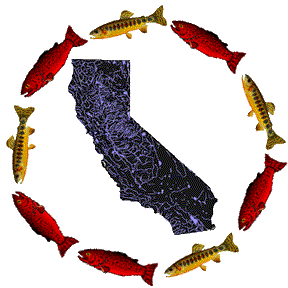CSPA |
| Your 501(c)(3) tax deductible cash donations are desperately needed if the fight for our fisheries is to continue. Read how you can donate! |

 More News
More News
![]()
Edited 9-19-08: 3:10pm
Information sought on San Luis Reservoir during 1980-81 drawdown in order to protect reservoir's fisheries
September 18, 2008 -- Scott Miller and Doug Lovell, NCCFFF, have asked if anyone can remember back to 1980 - 1981 when San Luis Reservoir had to be lowered to its lowest possible low point ( 7,900 acre ft) in order to fix the dam.
This inquiry is in connection with the San Luis Low Point Project. The San Luis Reservoir Low-Point Improvement Project has been established to fully utilize water supplies in San Luis Reservoir without interrupting water deliveries or impacting water quality to Santa Clara and San Benito counties, and to the Pajaro Valley area of Santa Cruz County.
The Santa Clara Valley Water District (SCVWD) holds that a significant proportion of the water supply to the tri-valley region is at risk due to degraded water quality in San Luis Reservoir when the water level reaches a "low point" during the summer. The low water level combined with hot weather encourages rapid growth of algae, which can foul the taste and odor of drinking water.
The SCVWD has spent the past two years identifying seven feasible solutions they believe address the San Luis Reservoir low-point problem:
Algae management in San Luis Reservoir using algicide application or algae harvesting; | Water treatment at a new facility at the Pacheco Pumping Plant using dissolved air flotation technology; | Construction of a new bypass conveyance corridor that would route water deliveries around San Luis Reservoir; | Extending and lowering the San Felipe intake pipe; | Construction of an expanded Pacheco Creek reservoir, if it can be done without affecting nearby Henry W. Coe State Park; | A combined solution, which could include modified operations of existing reservoirs, desalination and other regional water planning efforts (such as expanding Los Vaqueros Reservoir, tying in to the San Francisco Public Utilities Commission's Hetch Hetchy water supplies, etc.); | No project, as required under CEQA and NEPA, to compare the impacts of approving the project with the impacts of not approving the project. | |
The seven alternatives are undergoing further evaluation in a draft environmental impact report/environmental impact statement (EIR/EIS) which is scheduled for completion and public distribution in fall 2004. The water district project team continues to collect data on resources in the project area, initiating an impact analysis of the alternatives.
As part of the public's input to that EIR/EIS, Scott Miller and Doug are looking for what the actual state of the reservoir was during the last drawdown which occurred in 1980-81. Scott and Doug are hoping that some will remember what the water was like, fish kills, was there a striper fishery at that time. Was there any access to the water and was it algeaed up, etc. The information you provide will help with the following points that were discussed by Miller and Lovell at the Low Point Scoping meeting.
1. The enhancement of wildlife, fisheries and recreation was part of the
original authorizations of the San Luis Project at both the State and
Federal levels. See Public Law 86-488.
2. This has been accomplished and the facility has been enjoyed by thousands each year. We are especially aware of the fisheries aspect as
we are members of the Northern California Council of the Federation of Fly
Fishers (NCCFFF). This fishery is unique in that the Lake and Forebay are
considered " World Class " and account for many striped bass inland world
records.
3. It is our strong contention that one of the main ingredients of the
lakes success for fisheries and recreation has been the historic minimum
pool of approximately 500,000 acre ft. We are asking that this historic
minimum pool level be maintained and in doing so believe the Low Point Project is not necessary.
4. We believe the EIR/EIS must consider the minimum pool level and its
effect on wildlife, fisheries and recreation. A scientific study of the
Low Point effect on the fishery is mandatory. Any action that would lower
lake levels to the point of negative impact on the fishery is not acceptable.
We believe that lowering the lake minimum pool will cause waters to warm,
become poorly oxygenated, crowd fish populations, increase poaching
resulting in fish kills and disease.
5. It is not in the best interest of the struggling Delta to pump an
additional 100,000 to 400,000 acre ft. of water out of the Delta each year
to make up for waters used out of the minimum pool. Your EIR/EIS must
address this issue. Where will the additional water come from.
6. No one who enjoys the fishery, recreation, wildlife or just drives by
the lake wants to see San Luis turned in a disgusting low level mud hole.
This shallow, warm and muddy body of water would not support fish or
wildlife and boating, swimming, etc. would be impossible.
7. The EIR/EIS must consider the negative effect low point would have on
water quality.
8. As published, the given time lines for EIS/EIR do not allow time for
the necessary studies necessary to establish the correct minimum pool to
maintain and support fisheries, wildlife and recreation.
9. Please consider slowing down the EIR/EIS process, do the necessary
scientific studies necessary. Produce an EIR/EIS that is responsible and
fair.
10. Finally, maintain a minimum pool that leaves San Luis attractive, available for recreation, sustaining to fish and wildlife as was promised from the beginning.
If you have info, please email Scott Miller or Doug Lovell.